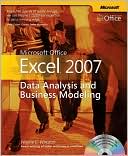Microsoft Office Excel 2007: Data Analysis and Business Modeling
Search in google:
Master the analysis and business modeling techniques that help you transform your data into bottom-line results. Award-winning business professor and corporate consultant Wayne Winston shares the best of his real-world experience in this practical guide—now updated for Excel 2007. Use Wayne’s proven practices and hands-on exercises to help you work smarter, make better decisions, and gain the competitive edge. Solve real-world business problems with Excel 2007! Maximize profits—determine NPV, optimize your product mix, calculate ROI Create best, worst, and most-likely case scenarios for sales Analyze investment performance and help minimize risk Track your personal finances, calculate loan terms, and plan for retirement Use trend and seasonality to forecast revenue Estimate a product’s demand curve and manage inventory with precision Interpret the effects of price and advertising on sales Assign a dollar value to customer loyalty Solve work scheduling problems and shorten wait times for customer service queues PLUS—predict outcomes of sporting events, presidential elections, and more! CD Includes: Sample files from each chapter Problem-and-solution sets—build your expertise! Fully searchable eBook A Note Regarding the CD or DVDThe print version of this book ships with a CD or DVD. For those customers purchasing one of the digital formats in which this book is available, we are pleased to offer the CD/DVD content as a free download via OReilly Medias Digital Distribution services. To download this content, please visit OReillys web site, search for the title of this book to find its catalog page, and click on the link below the cover image (Examples, Companion Content, or Practice Files). Note that while we provide as much of the media content as we are able via free download, we are sometimes limited by licensing restrictions. Please direct any questions or concerns to booktech@oreilly.com.
PrefaceIntroduction to Excel 2007: What’s New? Chapter 1: Range NamesChapter 2: Lookup FunctionsChapter 3: The INDEX FunctionChapter 4: The MATCH FunctionChapter 5: Text FunctionsChapter 6: Dates and Date FunctionsChapter 7: Evaluating Investments by Using Net Present Value CriteriaChapter 8: Internal Rate of ReturnChapter 9: More Excel Financial FunctionsChapter 10: Circular ReferencesChapter 11: IF StatementsChapter 12: Time and Time FunctionsChapter 13: The Paste Special CommandChapter 14: The Auditing ToolChapter 15: Sensitivity Analysis with Data TablesChapter 16: The Goal Seek CommandChapter 17: Using the Scenario Manager for Sensitivity AnalysisChapter 18: The COUNTIF, COUNTIFS, COUNT, COUNTA, and COUNTBLANK FunctionsChapter 19: The SUMIF, AVERAGEIF, SUMIFS, and AVERAGEIFS FunctionsChapter 20: The OFFSET FunctionChapter 21: The INDIRECT FunctionChapter 22: Conditional FormattingChapter 23: Sorting in ExcelChapter 24: TablesChapter 25: Spin Buttons, Scroll Bars, Option Buttons, Check Boxes, Combo Boxes, and Group List BoxesChapter 26: An Introduction to Optimization with Excel SolverChapter 27: Using Solver to Determine the Optimal Product MixChapter 28: Using Solver to Schedule Your WorkforceChapter 29: Using Solver to Solve Transportation or Distribution ProblemsChapter 30: Using Solver for Capital BudgetingChapter 31: Using Solver for Financial PlanningChapter 32: Using Solver to Rate Sports TeamsChapter 33: Importing Data from a Text File or DocumentChapter 34: Importing Data from the InternetChapter 35: Validating DataChapter 36: Summarizing Data by Using HistogramsChapter 37: Summarizing Data by Using Descriptive StatisticsChapter 38: Using PivotTables to Describe DataChapter 39: Summarizing Data with Database Statistical FunctionsChapter 40: Filtering Data and Removing DuplicatesChapter 41: Consolidating DataChapter 42: Creating SubtotalsChapter 43: Estimating Straight Line RelationshipsChapter 44: Modeling Exponential GrowthChapter 45: The Power CurveChapter 46: Using Correlations to Summarize RelationshipsChapter 47: Introduction to Multiple RegressionChapter 48: Incorporating Qualitative Factors into Multiple RegressionChapter 49: Modeling Nonlinearities and InteractionsChapter 50: Analysis of Variance: One-Way ANOVAChapter 51: Randomized Blocks and Two-Way ANOVAChapter 52: Using Moving Averages to Understand Time SeriesChapter 53: Winter’s MethodChapter 54: Forecasting in the Presence of Special EventsChapter 55: An Introduction to Random VariablesChapter 56: The Binomial, Hypergeometric, and Negative Binomial Random VariablesChapter 57: The Poisson and Exponential Random VariableChapter 58: The Normal Random VariableChapter 59: Weibull and Beta Distributions: Modeling Machine Life and Duration of a ProjectChapter 60: Introduction to Monte Carlo SimulationChapter 61: Calculating an Optimal BidChapter 62: Simulating Stock Prices and Asset Allocation ModelingChapter 63: Fun and Games: Simulating Gambling and Sporting Event ProbabilitiesChapter 64: Using Resampling to Analyze DataChapter 65: Pricing Stock OptionsChapter 66: Determining Customer ValueChapter 67: The Economic Order Quantity Inventory ModelChapter 68: Inventory Modeling with Uncertain DemandChapter 69: Queuing Theory: The Mathematics of Waiting in LineChapter 70: Estimating a Demand CurveChapter 71: Pricing Products by Using Tie-InsChapter 72: Pricing Products by Using Subjectively Determined DemandChapter 73: Nonlinear PricingChapter 74: Array Formulas and FunctionsAbout the Author








